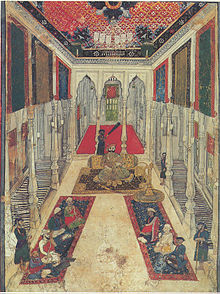
Back États princiers des Indes par nombre de coups de canon French Համազարկային պետություն Armenian Salve per gli stati indiani Italian 예포국 Korean Saluttstat NB Салютуемое княжество Russian வணக்கத்திற்குரிய சுதேச சமஸ்தானங்கள் (பிரித்தானிய இந்தியா) Tamil

| Princely state |
|---|
| Individual residencies |
| Agencies |
|
| Lists |
A salute state was a princely state under the British Raj that had been granted a gun salute by the British Crown (as paramount ruler); i.e., the protocolary privilege for its ruler to be greeted—originally by Royal Navy ships, later also on land—with a number of cannon shots, in graduations of two salutes from three to 21, as recognition of the state's relative status. The gun-salute system of recognition was first instituted during the time of the East India Company in the late 18th century and was continued under direct Crown rule from 1858.
As with the other princely states, the salute states varied greatly in size and importance. The states of Hyderabad and Jammu and Kashmir, both with a 21-gun salute, were each over 200,000 km2 in size, or slightly larger than the whole of Great Britain; in 1941, Hyderabad had a population of over 16,000,000, comparable to the population of Romania at the time, while Jammu and Kashmir had a population of slightly over 4 million, comparable to that of Switzerland. At the other end of the scale, Janjira and Sachin (11 and 9 guns, respectively, and both ruled by branches of the same dynasty) were respectively 137 km2 and 127 km2 in size, or slightly larger than the island of Jersey; in 1941, Janjira had a population of nearly 14,000, the smallest of the salute states[1] on the subcontinent.
For varying periods of time, a number of salute states in South Asia (Afghanistan), on the Indian subcontinent (Nepal, Bhutan, Sikkim) or in the Middle East (the Gulf/Trucial States and various states in the Aden Protectorate) were also under the British Raj as protectorates or protected states. As with the Indian principalities, those states received varying numbers of gun salutes and varied tremendously in terms of autonomy. Afghanistan and Nepal were both British protected states from the 19th century until 1921 and 1923, respectively, after which they were sovereign nations in direct relations with the British Foreign Office; while protected states, both enjoyed autonomy in internal affairs, though control of foreign affairs was left to the British. The states under the Persian Gulf Residency and the Aden Protectorate (part of the Bombay Presidency until 1937) ranged from Oman, a 21-gun-rated sultanate under a limited protectorate, to the 3-gun Trucial States which were near-total protectorates.
Following their independence in 1947, the new Indian and Pakistani governments maintained the gun-salute system until 1971 (in India) and 1972 (in Pakistan), when the former ruling families were officially derecognised. The Aden Protectorate was transferred to the control of the British Foreign Office in 1937 and eventually became the independent state of South Yemen in 1967, resulting in the abolition of its salute states the same year. Just prior to Indian independence in 1947, the Persian Gulf Residency was likewise transferred to Foreign Office control, remaining in existence until the Trucial States became fully independent in December 1971, forming the United Arab Emirates (UAE) in early 1972.

- ^ The India Office and Burma Office List: 1945. Harrison & Sons, Ltd. 1945. pp. 33–37.